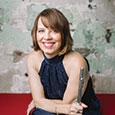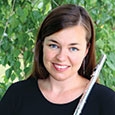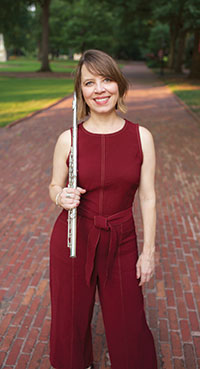 Jennifer Parker-Harley teaches flute at the University of South Carolina in Columbia and has performed as an orchestral flutist in the Columbus Symphony, Ft. Wayne Philharmonic, and Chautauqua Symphony. She has a keen interest in contemporary music and has premiered or commissioned numerous pieces that feature the flute in solo and chamber settings, including new works for flute and bassoon with her husband, bassoonist Michael Harley. For several years she has explored music for flute inspired by literature, particularly poetry and short stories. Her CD with pianist Lydia Brown and actress Robyn Hunt, Words and Music (Titanic label), includes masterworks by Debussy, Schubert and Reinecke, and incorporates readings of the poetry that inspired each piece.
Jennifer Parker-Harley teaches flute at the University of South Carolina in Columbia and has performed as an orchestral flutist in the Columbus Symphony, Ft. Wayne Philharmonic, and Chautauqua Symphony. She has a keen interest in contemporary music and has premiered or commissioned numerous pieces that feature the flute in solo and chamber settings, including new works for flute and bassoon with her husband, bassoonist Michael Harley. For several years she has explored music for flute inspired by literature, particularly poetry and short stories. Her CD with pianist Lydia Brown and actress Robyn Hunt, Words and Music (Titanic label), includes masterworks by Debussy, Schubert and Reinecke, and incorporates readings of the poetry that inspired each piece.
How did you first start playing the flute?
Both of my parents are musicians. My mom is an organist, and my dad plays jazz trumpet. I remember thinking that they always seemed to be having such a good time when they were playing, so I was very excited to start piano lessons in the second grade. I continued piano lessons through most of college, and in sixth grade I began playing flute in the middle school band. We had a flute choir that met after school, and I was hooked pretty early.
What led to your interest in music outside the standard flute repertoire?
I have been listening to my dad play jazz my whole life, and although I came to improvising pretty late in life and am still a total beginner, I love this music. I want to know the kind of freedom that comes with the amazing ear/hand coordination that improvisors have, and I think that 21st century musicians will increasingly need to have this skill. Improvising was an aspect of classical music until around the time of Beethoven when composers began to demand more control over the performance. I think we will find a return to improvising as people come to prize originality more and more in an increasingly automated and standardized world.
Music has given me many opportunities to travel and get glimpses into the music of other cultures. This past summer I taught at the Festival Inverno in Vale Veneto, Brazil and then visited a friend in São Paolo. I was so struck by the country’s rich musical heritage of samba, bossa nova, and choro. There are so many styles to explore. I find the endless possibilities represented by music of other cultures incredibly exciting. I also want to introduce my students to a diverse body of different styles. This fall, in my graduate flute literature class, they will be taking a look at the flute and flute music from four major non-European traditions: Brazil, India, China, and Japan.
What are some performance projects you have been involved with recently?
Last year, my husband, Mike Harley, who teaches bassoon at University of South Carolina, Rebecca Schalk Nagel, our oboe professor, and I commissioned Valerie Coleman and Jeff Scott, founding members of Imani Winds, to write chamber pieces inspired by the life of Richard T. Greener. He was the first African-American professor to teach at the University of South Carolina, serving from 1873-1877, during the era of Reconstruction. He was a well-known public speaker and a highly accomplished scholar and statesman: the first black graduate of Harvard, a government representative in India and Russia, and dean of Howard University Law School. As with so many women and people of color, his story was more or less forgotten, and his accomplishments went unacknowledged for many years. Fortunately, several years ago Greener’s story was rediscovered, and he was honored with the commissioning and unveiling of a statue on the U of SC campus.
As a part of the unveiling celebrations, Valerie and Jeff wrote two powerful new pieces for wind quintet and mixed chamber ensemble using text written by Greener as well as other poetry. We premiered the works in Columbia in April 2018. It was a real honor to play a small role in bringing Greener’s story to light.
What other music do you play?
I really enjoy playing chamber music. I was bitten by the chamber bug as a student at Eastman, where I was placed in a group that ended up playing together for all four years of college. We rehearsed every weekday morning, and there was a penalty for being late to rehearsal. I think it was to bring a box of doughnuts. The group was like a family and showed me how satisfying and creative small group playing can be. These days, I play a fair amount with my husband Mike and pianist Phillip Bush; we hope to record an album of music for flute, bassoon and piano soon. Mike is a founding member of the contemporary music group Alarm Will Sound, and because of his involvement with them, he knows many of the most exciting composers on the scene today. Several of them have written pieces for us that we hope to include on the album.
Every summer, I perform with Brazilian guitarist Camilo Carrara and percussionist Michele Humphreys from Towson State at the National Music Festival. While there is a huge body of work for flute and guitar, and many pieces for flute and percussion, strangely enough there is not much for all three instruments together. This is surprising, considering that these instruments are the oldest to be found in most musical cultures. We have done many ad hoc arrangements and also like to improvise together. It has been a real meeting of the minds and musical souls for us and is something that we are looking to build on in the future.
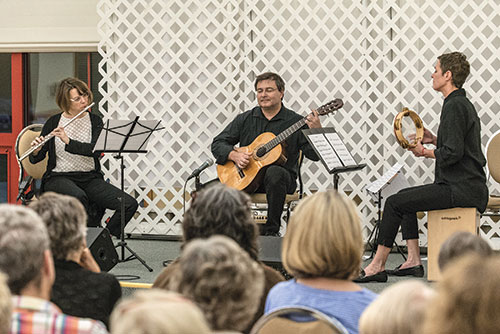
What has been your career path?
My first official position was as an adjunct faculty member at Wright State University in Dayton. After a year there, I moved to northern Indiana, where I taught flute and ear training at Goshen College, my husband’s alma mater. I also won a position as second flutist in the Fort Wayne Philharmonic that fall. I loved playing there. The orchestra members were all very supportive, and I got to play in a fantastic section with Elizabeth Rowe and Hilary Feibel.
After two years in those positions, I won the second flute position in the Columbus Symphony Orchestra in Ohio, where I played for eight seasons. Again, I was fortunate to be a member of a strong section that got along well and enjoyed playing together. My flute colleagues in Columbus were Randy Hester and Mindy Ewing. I loved playing second flute because of the focus on collaboration that it requires. While we lived in Columbus, I also taught flute at Otterbein College and subbed for one semester at Ohio University.
Over the last eleven years at University of South Carolina, I have found that I am just as passionate about the art of teaching as I am about playing the flute. Many people hold the belief that good teachers are born, not made: either you are good at teaching or you are not. I could not disagree more. I think that teachers can learn to develop their skills just as in any other field.
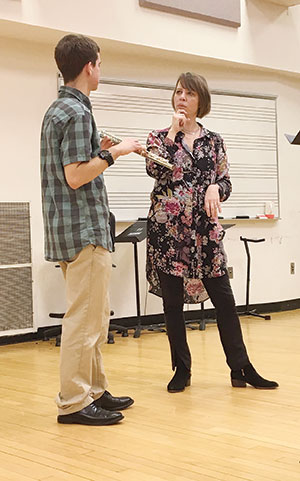
What do you believe is your most influential role as a professor?
I once read a quote from Columbia University English professor Edward Tayler that has stuck with me: “A college teacher’s job is to help the student ‘build a self.’” We are lucky in music to have the opportunity to learn mostly one-on-one in the age-old master/apprentice model. The complex and comprehensive nature of this relationship, coupled with the highly personal and emotional nature of creating and playing music, can result in an unusually close bond between student and teacher that often lasts a lifetime. Students entrust their dreams and futures to their teachers, and I feel a tremendous responsibility to nurture, protect and guide them as best as I possibly can. This requires that I guide each student in a highly individualized way to prepare them for their chosen paths. To accomplish this, I find that a holistic approach to the studio curriculum is absolutely necessary.
The training of an artist certainly focuses on skill-building and artistry, but should also address intellectual, mental and physical concerns. Deep score study, theoretical and formal analysis, and knowledge of style and historical context are important aspects of preparing any piece and can be a jumping-off point for interpretation. Alongside a solid intellectual framework, strong mental preparation can help students perform up to their potential. To this end, in addition to focusing on mental performance strategies in lessons and studio classes, I hold yearly retreats for my graduate students and seniors. In past retreats they have focused on peak performance, goal-setting, and skills related to successful collaboration. I have worked for years with performance psychologist Todd Kays, who is based in Columbus and has been our guest at U of SC on several occasions.
I also hope to cultivate good physical habits with my students. We have regular conversations about performance health. For example: how much practice is healthy physically? How can they cultivate strength and resilience without injury? What exercises can help recover from performance injuries? I frequently invite guests who are Alexander Technique and Body Mapping teachers and draw on the wisdom of several graduate students in the studio who have special training in these areas.
Do you have a specific curriculum for undergraduate and graduate study?
Again, the idea of holistic education guides my work with each student. In terms of technical development, I tend to be pretty methodical and structured. Every year the entire studio works through a technique book together. They have played Taffanel and Gaubert’s 17 Daily Exercises, Trevor Wye’s Daily Exercises, Walfrid Kujala’s Vade Mecum, and Andre Maquarre’s Daily Exercises for the Flute from cover to cover. I keep a chart in my office that tracks everyone’s progress. This is not meant to engender competition, but to keep us – both me and the students – on track in weekly lessons. It is easy to get distracted by an upcoming performance or audition, but the chart keeps technical fundamentals at the core of the daily routines. The point of all this technique, of course, is to ultimately be able to forget about it and concentrate on musicality and communication.
Students also work on fundamentals of sound production through whistle tones, harmonics and long tones. I have been a fan of Marcel Moyse’s Tone Development Through Interpretation ever since Bonnie Boyd introduced it to me at Eastman. I also have students find or, better yet, compose their own melodies to study tone and phrasing.
I am a big believer in the importance of etudes, so everyone prepares between one and three etudes a week for lessons. I tend to use etudes as a way to focus in on the learning process. For example I might address strategies for learning an etude that get it as close to performance-ready as possible in one week or ask students to think about how to apply what they learned from an etude one week with the etude they learn the next week. I use the eight opuses of Andersen etudes as a base, and then supplement that with other volumes such as those by Köhler, Boehm, Jean-Jean, and Castéréde.
In the artistic arena, I think one of the most important things I can do for my students is to instill habits of mind that encourage them think creatively and musically. These habits include deep listening and reading, in order to understand the influences and inspirations of any work of art; creative thinking, seeing unusual or new connections between things; and open-mindedness to criticism, collaboration, and new ideas.
Bonnie Boyd told me a story of her teacher, Joseph Mariano, asking her to prepare Syrinx in 13 different ways for a lesson. It was a daunting task, but this sort of exploration and the imagination it involves is essential in the development of artistry. I want students to think about the possibilities in any piece of music. Rather than thinking in terms of right and wrong as defined by someone else, I want them to feel prepared to develop their own interpretation of a work. I encourage them to ground that interpretation in historical knowledge of the composer and period and to look to the score. What is unusual about the structure of the melody? What about the harmony do you want the listener to be aware of? And sometimes, simply, which moments, turns of phrase, colors in the music do you, as the performer, love? I sometimes use the illustration of taking a visitor on a tour of your hometown; there are certain things you would highlight, and others you might choose to downplay. A performer guides the listener’s experience to hopefully communicate something of substance.
“In five years, you will be the same person you are today except for the books you read and the people you meet.” I read this quote a long time ago, and still think of it often. I do find that books are endlessly inspiring and educational. In order to help stimulate creativity, I started the U of SC Flute Studio Book Club. Every year the students vote on a book from a list I give them that we then read together over the course of the school year. Although the specific subjects have varied, most have related to artistry and creativity. We generally use studio class time several times a semester to discuss the book. Last year we read Practicing for Artistic Success by Burton Kaplan. He details many practice strategies, and then discusses their specific processes and results. This year we will be reading The Creative Habit by dancer and choreographer Twyla Tharp. I am very excited about this book as she espouses a dual approach to artistry that involves both discipline and creativity. This approach moves away from the idea that only special people are endowed with these abilities, and instead argues that anyone can develop artistry and creativity through consistent work, unflagging curiosity, and an open, experimental approach.
How do you promote a healthy studio environment?
I strive for a studio in which everyone feels that their input is valued, where experimentation and curiosity are encouraged and supported, and process and growth are valued over product. It is up to me to create this environment. My interactions with my students are extremely important. I try to stay away from the banking model of education, in which the student is an empty vessel into which the professor deposits their previously attained knowledge. Instead, I like to think that the student and I are traveling a path together. At times I take the lead on the journey and am happy to share what I have learned traveling my own path, but mostly, we are on a path of exploration and discovery together. I do recognize that I have many more years of experience than my students and try to share that when appropriate, but I also try to honor their experiences, ideas and curiosity. I have also found over the last eleven years at U of SC, that when each student is pursuing their own way forward, there is much less unhealthy competition and comparison between studio members. Everyone thrives in a community in which each person is valued and supported for their uniqueness.
How do you help students cope with inevitable rejection and setbacks?
Failures can be even more valuable than successes, since we all tend to reflect more after things don’t go the way we wanted. A few years ago, we had a studio goal of collecting 100 letters of rejection. That exercise required, most importantly, that people put themselves out there and apply for lots of things (competitions, festivals, performance opportunities). Through this effort, almost everyone had something positive happen. They all saw, in a very real and tangible way, that setbacks are crucial to progress and a part of every success story.
What skills should students explore to help them find success after graduation?
Today, musicians must be equipped to do much more than play their instrument at a very high level. I think we are moving into an age that prizes greater creativity and self-expression; even classical musicians, who for the last 100 years or so have been strictly in the business of interpretation are increasingly called upon to improvise, compose, and arrange. We also seem to have moved into a post-genre musical world – one in which music defies categorization and requires a lot of flexibility from the performer. In light of this, it is essential that flutists develop not only good reading skills but also strong aural skills that make improvisation and the seamless movement between genres and styles possible.
It is also important that students develop professional skills, and many music schools are retooling to include this type of training in music degrees. Performers have to know how to promote themselves, develop innovative ideas for the presentation of their music, procure grant money, and interact in a meaningful way with the community. The Carolina Flute Guild, our student organization, mounts three major events every year: the All-State Preparation Day for South Carolina middle and high school students who are preparing to take honor band auditions, the Flute Studio Alumni Recital, which brings a notable graduate back to the university for a performance and masterclass or talk, and Sounds Around Town and Pop-Up Music School, day-long events in which current students play outdoors and give lessons to passers-by around the city of Columbia. Students take charge of every aspect of these events including advertisement, fundraising, contract negotiations, event planning, logistics, teaching, and performing.
What led to these community programs?
Several years ago, I had the chance to visit Buenos Aires and took a tour of part of the city known for its beautiful and very active graffiti culture. The art feels like a living part of the city. I started to think about what the musical equivalent could be in Columbia. Sounds Around Town was what resulted. In the first year it was a 24-hour event, with flutists giving concerts every hour on the hour, somewhere in the city. We had some really interesting experiences. Some students played for a guy who was skyping his family back in Iran, while others played for a single biker who stopped to listen on a park path at 4:00 AM. The around-the-clock format, which was documented by a videographer, was a lot of fun and a great bonding experience for the studio. After that inaugural year, however, we have concentrated on the Main Street area in Columbia, which has a Saturday market. It is a really fun atmosphere to be a part of. People can engage with the music (or not) on their own terms. They don’t have to sit for a long time, dress up, and or buy a ticket. The student performers find that playing in this atmosphere is much less stressful than a formal concert, and it is great to get immediate feedback from the audience.
For the past two years, we have included a Pop-Up Music School as part of the Sounds Around Town. We have a tent as part of the Main Street market in which people can take ten-minute lessons on an instrument of their choice. We have gotten very positive responses from people who have participated, and it has given the flute studio a chance to work closely with other studios at the School of Music.
What is the Flutist’s Book of Days?
This is a recording project that I started with my students a couple of years ago. When it is finished, there will be a piece of flute music for every day of the year, attached to the particular day by the composer’s birthday. The goal is to roughly represent the U.S. racial and gender demographics with this project. For instance, about 50% of the population is female, so we hope to have half of the recordings be of music by women. So far, we have about 50 recordings collected on a website (
What new initiatives are you introducing to your studio?
This year lessons will be centered around Project-Based Learning. This is a method of education that has come into vogue in K-12 education, and to a lesser extent in secondary education. It is centered around an essential question: “How can we make (classical) music more relevant to more people in our community?” That sentence will guide every aspect of our studio life this semester, from repertoire choice to recital venues and programming. This is a student-driven approach to learning, and I am very excited to see where the students’ interests and curiosities lead us throughout the semester.
I have also started a flute quartet that will be working with the refugee community in Columbia. Music is a wonderful means of social connection, and it is exciting to see our field move in this direction through programs like Ensemble Connect, the Global Leaders Program, and the many orchestral initiatives across the country inspired by Venezuela’s El Sistema program. We will be delving into the work of initiatives like these to work with communities in Columbia.
How have you been involved with discussions about the future of music in higher education?
This was not something I thought much about before coming to the University of South Carolina in 2008, where the faculty takes the question of the future of music in higher education very seriously. Led by David Cutler, professor of Music Entrepreneurship, and the Dean, Tayloe Harding, we have hosted two College Music Society summits on the 21st Century School of Music. Both times, I was a team leader and met with other faculty from around the country and beyond who are grappling with what music means, or could mean, to our society, and how best to prepare students for the future. My takeaway from these events has been that students and faculty need to move away from playing for what writer Eric Booth refers to as the “Art Club” – that is, the 7% of the US population that is already engaged with art – and focus on making music a more integrated part of American culture.
This requires different skills than conservatories and music schools have traditionally taught. I think musicians should learn to improvise, to play a broader swath of music than the canon of Western classical music, and to develop habits of mind that allow them to think creatively about the future of the art. These kinds of changes can be a little scary and push students and teachers beyond their comfort zones, but that is where growth happens and is ultimately very rewarding.
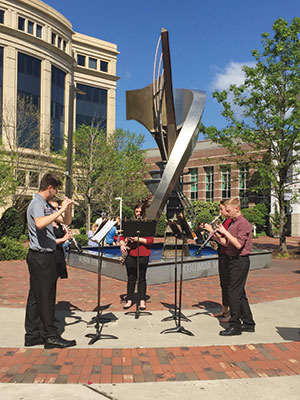
The Nifty Nine Warm-Up Routine
In a three-ring binder, students make a tab for each of the topics listed below. As they learn different ways to approach each of these fundamentals of flute playing, they put the exercise, handout or their typed observations under the correct tab. Then each day they practice something from each category.
Arpeggios
Articulation
Whistle Tones
Harmonics
Long Tones
Long Tones
with tuner
Vibrato
Melodies
Book Club List
What the Best College Teachers Do by Ken Bain
The Everyday Work of Art by Eric Booth
The Teaching Artist’s Bible by Eric Booth
The Talent Code by Daniel Coyle
Zen and the Art of Archery by Eugen Herrigle
Practicing for Artistic Success by Burton Kaplan
Kinkaidiana by John Krell
Bird by Bird by Ann Lamott
The Art of Asking by Amanda Palmer
The Creative Habit by Twyla Tharp
